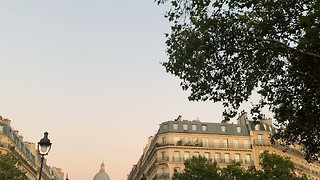Rediscovering Constable County
Isabel Dempsey talks about her newfound appreciation for her home county, where John Constable lived and painted his landscapes

Open rolling skies, swathes of verdant green, the murky depths of the Stour. I’d never really understood what all the fuss was about. I’d spent my childhood meandering across the fields of the Dedham Vale, and there really wasn’t much to them. No mysterious contours in the land, no strange flowers, groves of wild trees. It was all flat – a two-dimensional plane of earth, river, and sky.
And yet John Constable clearly saw something in this little corner of the world where we both grew up.
Personally, I didn’t have much patience for him – not only because Munnings was the far superior of the two Primary School houses – but because everyone just seemed a little bit obsessed with the guy. Whenever some family friend or relative came to stay, off my little legs had to go across the fields on what felt like a never-ending walk to Willy Lott’s Cottage. Random mills and locks were pointed out along the way, immortalised in murky dark oils somewhere in a London exhibit. If my family was feeling particularly tedious, into the Constable museum we’d go, until I was rewarded with scones and maybe a row down the Stour. And then, finally, there was the cottage every time, looking exactly the same and yet absolutely nothing like it does in Constable’s most famous painting, The Haywain.
“It wasn’t until recently that it clicked that Constable too belonged to this Romantic world”
As I grew up, I gained a greater appreciation for the area I lived in and developed a mild interest in Constable’s work. However, this interest largely stemmed from feeling like I ought to have some cultural connection to him, from the feeling of self-importance when I found my little village deemed special enough to be hung up in a gallery miles from home.
Other than that, his work just never really did it for me.
Yet, at some point in the last few years, my English student heart fell down a Jane Austen rabbit hole and into a world of Regency obsession, becoming particularly interested in the Romantics. Being very much the Marianne of Austen’s Sense and Sensibility, I too felt a connection to these highly emotional writers, finding themselves in the solace of nature, with their desire to protect the natural world from the growth of capitalism, to spark revolution.
But for all my reading of Keats, it wasn’t until recently that it clicked that Constable too belonged to this Romantic world. Picking up Regency Revolution in Waterstones one fateful day, I was surprised to find Constable’s name beside the likes of Byron, Austen, and Napoleon. I’d never thought of him as being a part of this world I loved so much, despite living in this exact moment of history.

I failed to recognise that in his depictions of the natural world, he was doing the same things as his poetical contemporaries. He was celebrating nature, asking us to pause for a moment and reflect on the beauty around us. His paintings were meant to be an escape from this increasingly modern and capitalistic world of trade and machines, a return to the pastoral and the picturesque. A fanciful flight from the poverty and smog of London, to the beautiful natural landscapes that had yet to be destroyed.
“I now possess a newfound love for his paintings and the area where I grew up”
And yet, even his landscapes aren’t entirely free from the human touch: workers are seen scurrying about, locks slicing and controlling the river, mills repurposing nature to human industrial ends, churches ruling over the natural world. A potential commentary begins to develop.
But for Constable, all of this human endeavour is brilliantly overshadowed (sometimes quite literally) by his big open Suffolk skies. The sea of sky is not pierced with mountains or scudded by hills, not scraped by trees or towers. The fervent texture of his brushstrokes, the depths of blue, white, and grey are meticulously layered until he makes this blue mass come alive.
Maybe it’s because I’ve lived in the Dedham Vale almost my whole life, but I don’t think I’m unique in thinking that the UK possesses much more sublime landscapes than Flatford – for it is quite literally ‘flat’. I, like Wordsworth, am more drawn to the awe-inspiring peaks of the Lake District. There you feel truly transported, lost in wilderness, possessed by their power. And yet, despite visiting the Lake District himself, Constable found little to record in their dazzling contours lush with green and copper foliage. Rather, he returned to his home, writing to his friend John Fisher in 1812 that “I should paint my own places best” as “painting is but another word for feeling”.
I now possess a newfound love for his paintings and the area where I grew up, and (out of term-time) live. I can see the Romantic in Constable, and turning Romantic myself try and see Dedham’s fields through his eyes, worthy to be hung inside a gilded frame of gold.
 News / Cambridge University Press criticises Meta’s ‘dismaying’ use of copyrighted material28 March 2025
News / Cambridge University Press criticises Meta’s ‘dismaying’ use of copyrighted material28 March 2025 News / Uni offers AI course for Lloyds employees30 March 2025
News / Uni offers AI course for Lloyds employees30 March 2025 Features / Cloudbusting: happy 10th birthday to the building you’ve never heard of30 March 2025
Features / Cloudbusting: happy 10th birthday to the building you’ve never heard of30 March 2025 News / Ski mask-wearing teens break into Caius accommodation27 March 2025
News / Ski mask-wearing teens break into Caius accommodation27 March 2025 Sport / Light Blues prevail in thrilling Varsity encounter29 March 2025
Sport / Light Blues prevail in thrilling Varsity encounter29 March 2025






